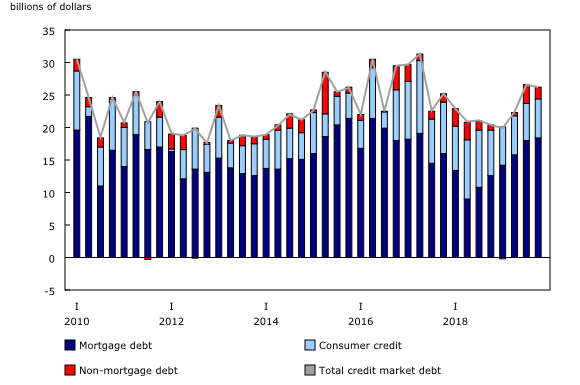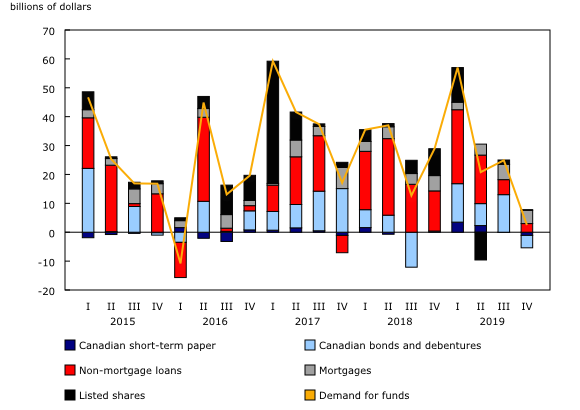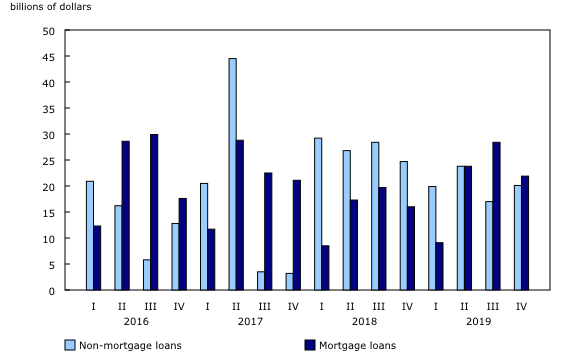National balance sheet and financial flow accounts, fourth quarter 2019
Archived Content
Information identified as archived is provided for reference, research or recordkeeping purposes. It is not subject to the Government of Canada Web Standards and has not been altered or updated since it was archived. Please "contact us" to request a format other than those available.
Released: 2020-03-13
National net worth grows as net foreign asset position improves
National net worth, the sum of national wealth and Canada's net foreign asset position, rose to $12,725.2 billion in the fourth quarter, up $182.7 billion from the previous quarter. Canada's net foreign asset position increased by $197.1 billion to reach $1,006.0 billion, fueled by the stronger performance of foreign stock markets relative to the Canadian stock market, which pushed up the value of Canada's international assets in equity instruments. This more than offset the decrease in the value of national wealth. On a per capita basis, national net worth increased to $336,009.
National wealth, the value of non-financial assets in the Canadian economy, edged down 0.1% to $11,719.2 billion in the fourth quarter. Contributing to this decrease was a 12.4% decline in the value of natural resources, as energy prices were down for the second consecutive quarter. Natural resources accounted for 7.4% of national wealth. Real estate, which accounts for more than three-quarters of national wealth, moderated the decline, growing 1.1% to $9,106.2 billion.
Household financial assets increase from revaluations
The household sector's net worth rose by $186.5 billion to $11,697.3 billion in the fourth quarter, as an increase in the value of assets more than offset an increase in liabilities. Compared with the fourth quarter of 2018, the value of financial assets increased 9.8%, whereas financial liabilities grew 4.1%.
The value of financial assets grew $153.8 billion, benefitting from $98.6 billion in upward revaluations in equity and investment fund shares, as both foreign and domestic equity prices increased. Aside from mutual fund shares, households' domestic equity holdings are about three times larger than their holdings of foreign equity. Since the large declines in stock markets at the end of 2018, households have added $329.2 billion to the value of their equity and investment fund shares; however, due to recent events, markets have posted large declines in the first part of 2020.
The value of non-financial assets, mainly real estate, rose $54.6 billion in the quarter. Year over year, residential real estate increased 3.3% in 2019 after lower growth in 2018 (+0.2%), due to a moderate rebound in house prices.
Household borrowing edges down
On a seasonally adjusted basis, total credit market borrowing edged down $0.4 billion to $26.2 billion in the fourth quarter. Demand for mortgage loans rose to $18.4 billion, while consumer credit and non-mortgage borrowing decreased to $7.8 billion. Households borrowed $95.1 billion over the course of 2019, compared with $85.3 billion over 2018, still below the preceding three years when borrowing consistently exceeded $100 billion.
The stock of credit market debt (consumer credit, and mortgage and non-mortgage loans) totalled $2,309.0 billion. Mortgage debt was $1,508.5 billion, accounting for nearly two-thirds of total debt, a share that has remained relatively stable since 2016. Consumer credit and non-mortgage loans stood at $800.5 billion.
The household debt service ratio, measured as total obligated payments of principal and interest on credit market debt as a proportion of household disposable income, rose to 14.98%, as total debt payments (+1.5%) outpaced disposable income (+1.3%). Total debt payments were 6.9% higher in 2019 than in 2018, while household disposable income increased 4.9% relative to 2018.
Household credit market debt as a proportion of household disposable income declined from 176.6% to 176.3%. In other words, there was $1.76 in credit market debt for every dollar of household disposable income.
Federal government demand for credit market debt remains positive
The federal government demand for credit market debt was $1.6 billion, as net issuances of bonds offset net retirements of short-term paper. This marks the seventh consecutive quarter where debt issuances outstripped debt retirements. On the other hand, other levels of government (excluding social security funds) increased borrowing in the fourth quarter to $9.2 billion, primarily in net issuances of short-term paper (+$6.9 billion) and bonds (+$1.6 billion).
The ratio of federal government net debt (book value of total financial liabilities less total financial assets) to gross domestic product (GDP) edged down to 26.2%, as GDP grew at a faster pace than federal government net debt. The ratio of other government net debt excluding social security funds (book value) to GDP was unchanged at 26.9%.
Demand for funds by non-financial private corporations falls
The demand for funds by non-financial private corporations was $2.5 billion, the lowest level since the first quarter of 2016. Net retirements of bonds (-$4.3 billion) and short-term paper (-$1.1 billion) contributed to the reduced borrowing. Demand for non-mortgage loans totalled $3.0 billion, provided mainly by chartered banks.
The debt-to-equity ratio (market value) of private non-financial corporations fell from 189.4% to 187.1% in the fourth quarter. The debt-to-equity ratio was 192.6% in the fourth quarter of 2018.
Financial sector lending dips
The financial sector provided $53.0 billion in funds to the economy through financial market instruments in the fourth quarter, down from $91.2 billion in the previous quarter. Fourth quarter financing was mainly in the form of mortgages (+$21.9 billion) and non-mortgage loans (+$20.1 billion). Purchases of domestic bonds were down to $12.8 billion from $43.8 billion in the previous quarter. In the fourth quarter, the bulk of non-mortgage loans went to non-residents (+$12.5 billion).
Among financial corporations, the market value of financial assets rose $306.4 billion to $15,613.3 billion. This was primarily due to increased financing and other transactions (+$168.0 billion), led by purchases of foreign equity and loans. Upward revaluations and other volume changes of $138.4 billion, mainly in foreign equity, also contributed to the higher market value.
Mutual funds and trusteed pension plans, two sectors where wealth is predominantly held by households, showed growth in the value of their financial assets. This helped bolster the net worth of households through their holdings of equity, investment fund shares, and pensions.
Note to readers
Revisions
This fourth quarter release of the national balance sheet and financial flow accounts includes revised estimates from the first quarter of 2019 to the third quarter of 2019. These data incorporate new and revised data, as well as updated data on seasonal trends. Additionally, as of the previous release, new financial subsector details are available. The subsector "Other private financial institutions" was broken down into additional financial subsectors and specific financial sectors have been re-grouped. This will help align more closely with current international classifications. An overview of these changes to the sector classification and information on other conceptual, methodological, and statistics revisions is available in "An overview of revisions to the Financial and Wealth Accounts, 1990 to 2019" (13-605-X).
In the near future, data enhancements to the national balance sheet and financial flow accounts, such as the development of detailed counterparty information by sector, will be incorporated. To facilitate this initiative and others, it is necessary to extend the annual revision period (normally the previous three years) at the time of the third quarter release. Consequently, for the next two years, with the third quarter release of the financial and wealth accounts, data will be revised back to 1990 to ensure a continuous time series.
Financial and wealth accounts on a from-whom-to-whom basis: Selected financial instruments
The data visualization product "Financial accounts on a from-whom-to-whom basis, selected financial instruments" has been updated with data from the first quarter of 2019 to the fourth quarter of 2019. This update also includes the addition of one new instrument: non-mortgage loans.
Next release
Data on the national balance sheet and financial flow accounts for the first quarter will be released on June 12.
Overview of the Financial and Wealth Accounts
This release of the Financial and Wealth Accounts comprises the National Balance Sheet Accounts (NBSA), the Financial Flow Accounts (FFA), and the other changes in assets account.
The NBSA are composed of the balance sheets of all sectors and subsectors of the economy. The main sectors are households, non-profit institutions serving households, financial corporations, non-financial corporations, government and non-residents. The NBSA cover all national non-financial assets and all financial asset-liability claims outstanding in all sectors. To improve the interpretability of financial flows data, selected household borrowing series are available on a seasonally adjusted basis (table 38-10-0238-01). All other data are unadjusted for seasonal variation. For information on seasonal adjustment, see Seasonally adjusted data – Frequently asked questions.
The FFA articulate net lending or borrowing activity by sector by measuring financial transactions in the economy. The FFA arrive at a measure of net financial investment, which is the difference between transactions in financial assets and liabilities (for example, net purchases of securities less net issuances of securities). The FFA also provide the link between financial and non-financial activity in the economy, which ties estimates of saving and non-financial capital acquisition (for example, investment in new housing) to the underlying financial transactions.
While the FFA record changes in financial assets and liabilities between opening and closing balance sheets that are associated with transactions during the accounting period, the value of assets and liabilities held by an institution can also change for other reasons. These other types of changes, referred to as other economic flows, are recorded in the other changes in assets account.
There are two main components to this account. One is the other changes in the volume of assets account. This account includes changes in non-financial and financial assets and liabilities relating to the economic appearance and disappearance of assets, the effects of external events such as wars or catastrophes on the value of assets, and changes in the classification and structure of assets. The other main component is the revaluation account, showing holding gains or losses accruing to the owners of non-financial and financial assets and liabilities during the accounting period as a result of changes in market price valuations.
At present, only the aggregate other change in assets is available within the Canadian System of Macroeconomic Accounts; no details are available on the different components.
Definitions concerning financial indicators can be found in Financial indicators from the National Balance Sheet Accounts and in the Canadian System of Macroeconomic Accounts glossary.
Products
The data visualization product "Financial accounts on a from-whom-to-whom basis, selected financial instruments," part of Statistics Canada— Data Visualization Products (71-607-X), is now available.
The Economic accounts statistics portal, accessible from the Subjects module of our website, features an up-to-date portrait of national and provincial economies and their structure.
The Latest Developments in the Canadian Economic Accounts (13-605-X) is available.
The User Guide: Canadian System of Macroeconomic Accounts (13-606-G) is available.
The Methodological Guide: Canadian System of Macroeconomic Accounts (13-607-X) is available.
Contact information
For more information, or to enquire about the concepts, methods or data quality of this release, contact us (toll-free 1-800-263-1136; 514-283-8300; STATCAN.infostats-infostats.STATCAN@canada.ca) or Media Relations (613-951-4636; STATCAN.mediahotline-ligneinfomedias.STATCAN@canada.ca).
- Date modified:









